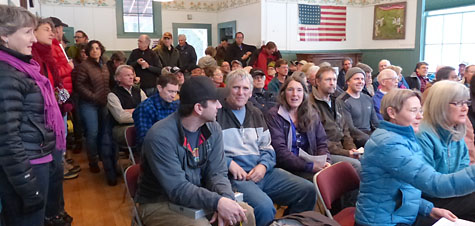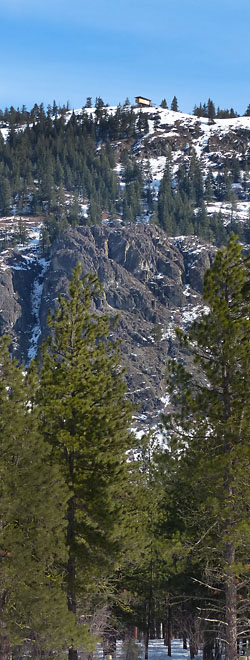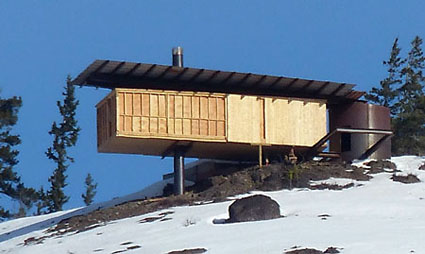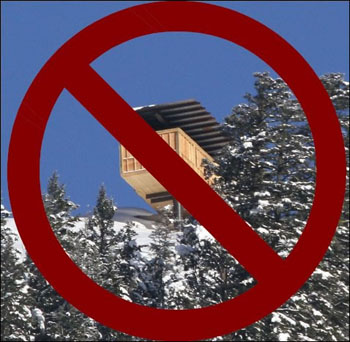 Bill Pope led the packed but orderly meeting. Spirited Community
Ridgetop hut discussed
story and photos by Sheela McLean
Mazama residents filled their community club - standing room only and out the door - Sunday (Feb. 17) to express their opposition to a structure high above them on Flagg Mountain. One part-owner of the hut, Ben Rand, also was there.
Bill Pope led the meeting, saying that he had felt “a strong undercurrent of opinion in the valley” against the hut, which is on the skyline above Mazama. “It seemed wrong to just let it go.”
About 125 signed into the meeting. Organizer Midge Cross estimated “almost 200 people there.”
Pope was careful to state “I don’t want this to become a personal thing” against the owners and architect: the meeting was orderly and brief - about an hour.
“People can make mistakes,” Pope said: the purpose of the meeting was to find a solution. Moving the hut back off the skyline “Is what we’re primarily interested in,” he added. “I don’t think this community is going to give up. (Applause) We want to just back away from the idea of litigation.”
Various solutions were discussed at the meeting. A poster showed how the building would look if it were painted black. Someone spoke of screening vegetation. But the suggestion that appeared to have the most muscle was moving the hut. Residents said that the hut could be moved successfully and that it could be placed in a good site - off the skyline - on the same property.
 The Mazama Community Club was filled over capacity at Sunday’s meeting. However, the possibility of a lawsuit was mixed into the discussion. A poster of a covenant placed on the land when sold in 2011 was front and center next to Pope: "All improvements placed on the property shall be constructed with restraint and special sensitivity and consideration in order to minimize the visual impact of any such improvements on adjoining parcels and on all other lands, including lands located on the floor of the Methow Valley and all other lands which have a direct line of sight to the property."
There is no law against building on the skyline in Okanogan County, according to Dave Ebenger who stood and spoke. Any legal action would hang on the covenants tied to the property.
The controversial hut is permitted for residence only sixty days per year and has no source of heat and no indoor plumbing. Pope said there are 65 such building permits in Okanogan County, seven of them in the Methow Valley.
People can legally stay in the hut for 60 days per year, “but we have to look at it for 365,” said Pope.
PJ Smith had the last word at the meeting: “We all want to be part of this community and get this resolved so that they can be part of our community as well.”
2/18/2013
 The controversial building is visible on the skyline from much of the land in and around Mazama. Photo by Sheela McLean Blight?
Flagg Mt. hut draws ire
by Solveig Torvik
Residents concerned about the visual “blight” of a hut designed by a prominent Seattle architect - and erected to jut out from the ridge top of Flagg Mountain - will hold a public meeting Sunday, February 17 at 5 p.m. at the Mazama Community Club.
The purpose of the meeting is to inform the public about “the disappointing decision” made by the hut’s owners and architect “to violate the ridgeline of Flagg Mountain and the covenants that previous owners had imposed on the property,” according to meeting organizers.
“We want to bring the community together for some clarity,” said Mazama resident Midge Cross. “It’s not to be acrimonious or cast stones but to inform the community,” she said. “I don’t know what our options are.”
 The unfinished Flagg Mountain hut. Photo by Sheela McLean Cross said the group has started a legal fund and “The group has offered to use those funds to help move the hut.” But they have been told by the owners that it would cost $300,000. “That seems excessive,” she added.
Jim Dow, president and co-founder of Schuchart Dow Construction in Seattle is a part owner. The firm specializes in “one-of-a -kind, architecturally significant” buildings, according to the company website. The internationally noted Seattle architect Tom Kundig of Olsen Kundig Architects designed the hut; he and his wife are part owners. Ben Rand is the fourth owner of the hut, according to Dow.
Dow told Grist that the owners felt they were adhering to the covenants and said they were saddened by the community’s response. “It’s not a happy situation,” said Dow. “We’ve gotten a lot of negative reaction,” though he added that some people in the valley have indicated they like it. “They think it’s beautiful,” he said. “What I’d like to encourage is that people engage us in conversation.” Dow added that he and Mazama resident Bill Pope and part-time valley resident Peter Goldman have been engaged in e-mail exchanges in search of a resolution.
 Opponents of the skyline building have built a website, movethehut.org, which includes this image. Dow, who said he’s been coming to the Methow for 45 years, added that he was surprised by “the difference of Mazama and Winthrop,” where he noted some so-called “ridge-buster” homes have been allowed. “I had no understanding that Mazama sees itself as different than down valley. That’s a big surprise. We sort of see the whole valley as the whole valley,” Dow said.
Meanwhile Mazama opponents of the hut have registered their architectural review of the project in unvarnished prose: “For the sake of a cabin that is permitted for use no more than 60 days per year, Dow-Kundig-Rand have saddled the Mazama community with a blight on the landscape that we will be forced to endure 365 days a year,” the public announcement of the meeting stated.
“We don’t live up there any longer but we kept all this crap off the skyline for 50 years,” added Winthrop resident John Hayes, one of the former owners of the property. He said he and the other owners attached covenants to the property to prevent environmental eyesores that would be visible from the valley floor, but the hut projects out over the edge of the ridge top. The covenants don’t leave “any questions” about the sellers’ intention that any structure on the property should be sensitively built and blend into its environment, Hayes said. “I felt they just disregarded it,” he added. Dow told Grist that a letter he received from Hayes and the other former owners was the first indication that anyone was unhappy about the project.
“This is about a whole community. It’s not about one individual’s wishes,” Hayes told Grist. “To the people on the valley floor, it looks like they’re getting the bird flipped to them.”
2/13/2013
|
